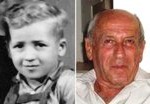 It’s most likely that Menachem Bodner last saw his identical twin in 1945, in Dr. Josef Mengele’s gruesome Auschwitz laboratory. He was 4 then and doesn’t remember his time in the notorious death camp. But in the 68 years that have followed, Bodner says he’s “always” been certain he was one of a pair. He just didn’t have any proof until this past year. Now, he’s searching for Jeno, a man who probably looks just like him, and who has a distinctive “A-7734” tattoo on his forearm. And 1 million Facebook users are helping him look.
It’s most likely that Menachem Bodner last saw his identical twin in 1945, in Dr. Josef Mengele’s gruesome Auschwitz laboratory. He was 4 then and doesn’t remember his time in the notorious death camp. But in the 68 years that have followed, Bodner says he’s “always” been certain he was one of a pair. He just didn’t have any proof until this past year. Now, he’s searching for Jeno, a man who probably looks just like him, and who has a distinctive “A-7734” tattoo on his forearm. And 1 million Facebook users are helping him look.

The arrival of a train containing Jews deported to the Auschwitz death camp in Poland. Inset: Menachem Bodner at age 5.
Mengele, known among prisoners as “the Angel of Death,” was deeply fascinated with twins and used them for research experiments in his macabre Auschwitz lab. Thankfully, Bodner, now 72, has no recollection of the cruelty he most certainly endured while undergoing experiments, though he can remember a sense of paralyzing fear. Unfortunately he also has few impressions of his family’s prewar life in a small town east of Munkacs, Hungary, which is now in the Ukraine. But despite the lack of memories from a war-marred childhood, Bodner says that throughout his life he’s felt a deep connection with his twin-and is positive he’s still alive and out there. But where?
Until last May, Bodner didn’t even know that his own name was once Elias Gottesmann. Now he knows that. And he knows for certain that he has a twin-thanks to the Nazis’ dogged, pathological documentation of their crimes. Ayana KimRon, a professional genealogist in Israel, found the evidence, clearly written in a record put together by the organization Candles, of twins who were “identified as having been liberated at Auschwitz or from a subcamp”:
KimRon got onto the case after spotting a posting made on a genealogical forum by a cousin of Bodner’s partner, seeking information about the long-missing brother. When the woman was unable to answer KimRon’s questions, Bodner ended up calling the curious researcher himself. “I was hooked,” KimRon says of that first call. “I said, ‘Look I’m going all the way with you,’ and it turned out to be the project of my life.” Bodner, a retired Israeli tax-service employee living in the Tel Aviv suburb of Rishon LeZion, was dubious at first, but KimRon began digging anyway. She asked him if he had any sense of his brother, and he told her, “All my life I’ve known that he was alive somewhere; I felt that he was alive.”
In early March, after months of dead-end trails and fruitless posts within the Jewish and genealogical communities online, KimRon decided the campaign needed a broader audience. She created a Facebook page titled “A7734,” posted a black-and-white shot of a young boy and a caption with his tattoo number, and asked for any clues into his whereabouts. Within 24 hours it had gone viral, and a within a week, the photo has had 23,000 shares, 1.13 million views, and hundreds of comments from readers offering resources, prayers, and words of encouragement. Other twins pledged to help. Amateur etymologists traced their names. One man even attempted to age the photo into what Jeno (known by his nickname Jolli) might look like now.

Menachem Bodner at age 5 after World War II (left) and in the present day.
As they approached the Auschwitz gates, the 5-year-old panicked. “I don’t want to go there,” he screamed. “They turn people to dust in there; I don’t want to go there.”
“I was astonished by the amount of comments, and I’m very grateful for each and every one one of them,” Bodner, who speaks Hebrew, says of the rapid response. Before talking to The Daily Beast, he and KimRon had been watching the page, mesmerized as the comments and countries rolled in: China, Argentina, Ireland, Portugal, Finland. The success is galvanizing, and Facebook is just the beginning. “I’m going to maximize the Internet,” KimRon says, explaining that her next plan is to build a YouTube channel of Bodner speaking (a Twitter account launched Sunday night).
In 1945, as allied troops advanced into Poland and the Germans fled Auschwitz-the most notorious of Nazi death camps-a boy approached a young Jewish man searching for his family and asked: “Will you be my father?” When the man asked his name, young Elias Gottesmann took a guess, saying his first name was Mendele and giving a similar-sounding last name. More than a half-century later, he laughs and shrugs when asked how he came up with that new name.
Source: THE DAILY BEAST
{Matzav.com Newscenter}











